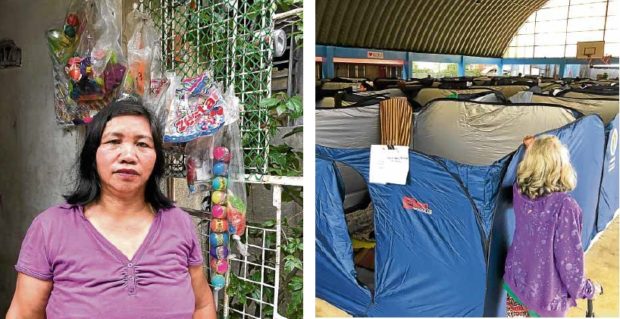Written by: Jhesset O. Enano, Philippine Daily Inquirer
(Last of three parts)
MANILA, Philippines — From on top of a cabinet at the second floor of their house in Marikina City, Nora Cencil and her three young children watched in fear as the brown and murky floodwaters threatened to inundate their perch.

Cencil — who had given birth to her youngest just four days before Tropical Storm “Ondoy” (international name: Ketsana) struck Metro Manila on Sept. 26, 2009 — immediately thought: This must be where we all meet our end.
Her neighbors in Barangay Malanday, however, extended a wooden plank from the third-floor level of their house across the street, allowing Cencil and her children to escape to safety.
“I kept on praying: Dear God, I hope we don’t die,” she said.
In just six hours, Ondoy dumped an unprecedented volume of rainwater on Metro Manila and adjacent provinces. Over 700 people were killed, as floodwaters engulfed houses and buildings, and temporarily paralyzed government services.
Even after a decade, the memories from that day still haunt Cencil. Even a brief recollection—such as wrapping her newborn baby in a rice sack to shield him from the cold—always brings her to tears.
Cencil was not alone. In her small community in Purok Sais, a patchwork of houses only meters away from the Marikina River, the women live in a constant state of uncertainty over the possibility of the next Ondoy. While their stories of survival vary, a sense of collective trauma still hangs over them, coupled by the continuing challenge to get back on their feet, despite the passage of 10 years.
In general, women are already weighed down by a lot of concerns, but disasters compound their burden and disproportionately affect them, said Hanna Fiel, head of the research and public information department of the Citizens’ Disaster Response Center, a nongovernment group focused on community-based disaster management.
Additional burden
“In the Philippines, the task to take care of the family usually falls on the women. When disaster strikes, and someone gets injured or dies, the women are expected to do something about it, even as she is already affected by the disaster and in a difficult situation,” Fiel said.
When Ondoy hit, women in Purok Sais suffered the brunt of the disaster as their husbands were at work.
After the floods subsided the following day, it was Cencil, still recovering from childbirth, who had to go to the drugstore to buy medicine for her husband who came down with a case of leptospirosis while cleaning their house.
She also had to care for their young son who stepped on broken glass during the cleanup.
On top of looking after their family’s social and emotional needs, women also bear the economic burden of providing for their loved ones after a disaster, said Libby Dipon, a “kagawad” of Barangay Industrial Valley Complex and a coordinator for Gabriela Women’s party in Marikina City.
All these responsibilities take a toll on women’s physical, mental and emotional health.
Lack of psychosocial services
Unfortunately, few to no psychosocial services at that time were offered to the survivors—men and women alike—which could have helped them process their fears and emotions, Dipon said.
Over the years, however, the local government of Marikina City has taken steps to ensure that its disaster preparedness and response would be more gender-sensitive.
A standout program of the city was the provision of modular or partition tents for evacuees in shelters. These were used as recently as August 2018, when heavy rains due to the southwest monsoon caused Marikina River to swell to 20.6 meters above sea level, just a few meters below Ondoy’s record of 23 meters.
Aside from ensuring order in the temporary shelters, the tents also provide privacy and protection for women and child evacuees, said Dave David, chief of the city’s disaster risk reduction and management office.
Research has already shown that after disasters, women are more prone to sexual exploitation and harassment.
Evacuation camps in Marikina also designate special rooms for lactating and pregnant women, aside from other vulnerable sectors such as the disabled and elderly.
Data collection is also done to determine who among the women have particular needs, such as sanitary napkins and medicines, said Honey Fernando, assistant city health officer.
Learning from the lessons of Ondoy and succeeding calamities, the city also now provides psychosocial support for survivors, Fernando said.
“If they have been in the camps for more than three days, we will provide stress debriefing,” she said, noting that barangay health workers could also follow up on survivors who may have other psychosocial needs after returning home.
Reducing vulnerability
Yet even with these efforts, the best way to reduce vulnerability in times of disaster is to address poverty among communities, especially among women without their own sources of income, Fiel said.
Despite living in a flood-prone area, Cencil could not see herself leaving her home in Malanday, as opportunities elsewhere were scarce.
“The past few years have been really difficult. I feel that I have not really bounced back,” she said. Along with their personal belongings, the floods swept away her “sari-sari” store and eatery, which provided her at least P3,000 daily.
Despite these challenges, Cencil has found strength through the group of women survivors in Purok Sais.
“Sometimes we just gather here in front of my home to talk,” she said. “It’s already a big deal for us to be able to share our stories.”



